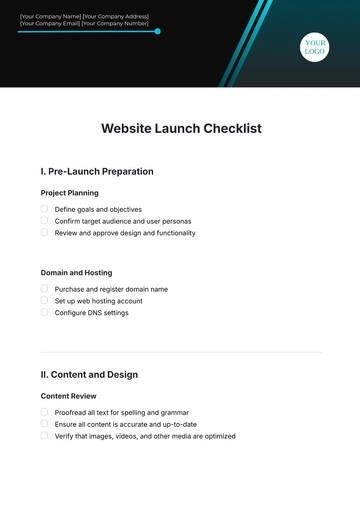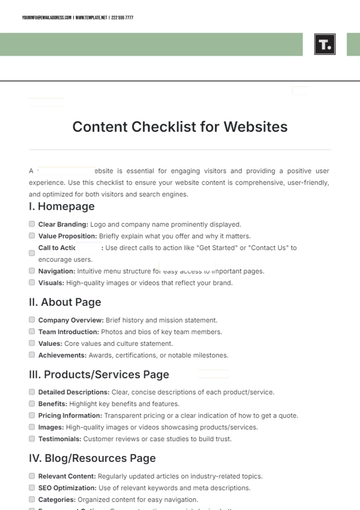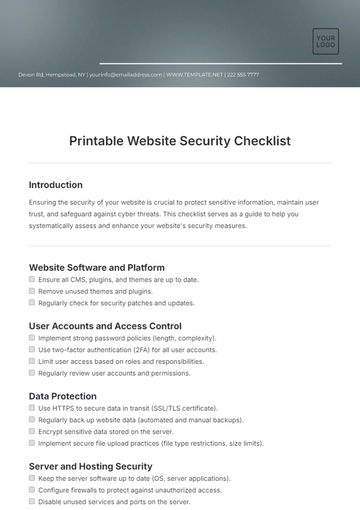Free Job Site Checklist

This checklist is created by [Your Name] of [Your Company Name] to ensure the safety and compliance at the work site. It serves to provide an extensive list of tasks to keep a job site secure and abide by relevant regulatory guidelines. Here are three key objectives that the checklist aims to achieve:
To make certain that the work environment adheres to safety standards and regulations.
To ensure the well-being and safety of all employees on the job site.
To prevent any incidents or accidents that may occur due to misuse or negligence.
Site Safety and Compliance:
Begin with a comprehensive safety assessment to identify potential hazards and ensure compliance with local safety regulations.
Implement and reinforce safety measures, ensuring that all workers are equipped with the necessary personal protective equipment (PPE).
Work Area Organization:
Emphasize the importance of an organized work area to optimize workflow and reduce the risk of accidents.
Confirm that tools, equipment, and materials are properly stored and easily accessible, contributing to a safe and efficient work environment.
Permit and Documentation Validation:
Thoroughly review and validate all required permits, licenses, and documentation relevant to the job site.
Ensure that the necessary regulatory approvals are in place and readily accessible for inspection.
Equipment Inspection and Maintenance:
Regularly inspect all machinery, tools, and equipment to guarantee proper functioning.
Schedule routine maintenance to address wear and tear, promoting both safety and operational efficiency.
Environmental Compliance:
Evaluate the environmental impact of the job site and implement measures to minimize ecological disruption.
Adhere strictly to environmental regulations, emphasizing responsible waste disposal and sustainable practices.
Effective Communication Channels:
Establish clear and efficient communication channels among team members, contractors, and stakeholders.
Foster an environment that encourages open dialogue, regular updates, and collaborative problem-solving.
Schedule and Timeline Management:
Develop and adhere to a detailed project schedule outlining key milestones and deadlines.
Regularly review and adjust the schedule as needed to ensure the project stays on course.
Quality Control Inspections:
Conduct rigorous quality control inspections to uphold the highest standards of workmanship.
Promptly address any deviations from project specifications to maintain overall quality.
Material Deliveries and Inventory Management:
Monitor and manage material deliveries to prevent shortages and delays.
Maintain an organized inventory system to track materials and streamline project progression.
Employee Training and Certification:
Confirm that all on-site personnel have received proper training and possess the necessary certifications.
Conduct ongoing training sessions to keep workers updated on safety protocols and job-specific skills.
Weather Considerations and Contingency Planning:
Stay vigilant about weather forecasts and develop contingency plans for adverse weather conditions.
Establish protocols for working in various weather scenarios, ensuring the safety of workers and the protection of materials and equipment.
Budget and Cost Control Measures:
Monitor project expenses closely, adhering to the approved budget.
Implement cost control measures and seek approvals for any necessary adjustments.
Community Engagement and Stakeholder Coordination:
Foster positive relationships with the local community by proactively communicating project updates.
Coordinate effectively with various stakeholders, including clients, contractors, and regulatory authorities.
Record Keeping and Documentation Management:
Maintain meticulous records of project-related activities, including daily reports, inspections, and correspondence.
Organize documentation systematically for easy retrieval and reference throughout the project's lifecycle.
Continuous Improvement Strategies:
Encourage a culture of continuous improvement by seeking feedback and evaluating project performance.
Implement lessons learned from previous projects to enhance overall efficiency and effectiveness.
- 100% Customizable, free editor
- Access 1 Million+ Templates, photo’s & graphics
- Download or share as a template
- Click and replace photos, graphics, text, backgrounds
- Resize, crop, AI write & more
- Access advanced editor
Efficiently manage job sites with the Job Site Checklist from Template.net. This editable and customizable template, effortlessly tailored with our Ai Editor Tool, ensures a personalized and efficient routine. Elevate your site management experience with this user-friendly checklist, designed for maximum efficiency. Customize effortlessly, ensuring comprehensive task management and successful job site operations with ease and precision.
You may also like
- Cleaning Checklist
- Daily Checklist
- Travel Checklist
- Self Care Checklist
- Risk Assessment Checklist
- Onboarding Checklist
- Quality Checklist
- Compliance Checklist
- Audit Checklist
- Registry Checklist
- HR Checklist
- Restaurant Checklist
- Checklist Layout
- Creative Checklist
- Sales Checklist
- Construction Checklist
- Task Checklist
- Professional Checklist
- Hotel Checklist
- Employee Checklist
- Moving Checklist
- Marketing Checklist
- Accounting Checklist
- Camping Checklist
- Packing Checklist
- Real Estate Checklist
- Cleaning Checklist Service
- New Employee Checklist
- Food Checklist
- Home Inspection Checklist
- Advertising Checklist
- Event Checklist
- SEO Checklist
- Assessment Checklist
- Inspection Checklist
- Baby Registry Checklist
- Induction Checklist
- Employee Training Checklist
- Medical Checklist
- Safety Checklist
- Site Checklist
- Job Checklist
- Service Checklist
- Nanny Checklist
- Building Checklist
- Work Checklist
- Office Checklist
- Training Checklist
- Website Checklist
- IT and Software Checklist
- Performance Checklist
- Project Checklist
- Startup Checklist
- Education Checklist
- Home Checklist
- School Checklist
- Maintenance Checklist
- Planning Checklist
- Manager Checklist
- Wedding Checklist
- Vehicle Checklist
- Travel Agency Checklist
- Vehicle Inspection Checklist
- Interior Design Checklist
- Backpacking Checklist
- Business Checklist
- Legal Checklist
- Nursing Home Checklist
- Weekly Checklist
- Recruitment Checklist
- Salon Checklist
- Baby Checklist
- Equipment Checklist
- Trade Show Checklist
- Party Checklist
- Hospital Bag Checklist
- Evaluation Checklist
- Agency Checklist
- First Apartment Checklist
- Hiring Checklist
- Opening Checklist
- Small Business Checklist
- Rental Checklist
- College Dorm Checklist
- New Puppy Checklist
- University Checklist
- Building Maintenance Checklist
- Work From Home Checklist
- Student Checklist
- Application Checklist





























